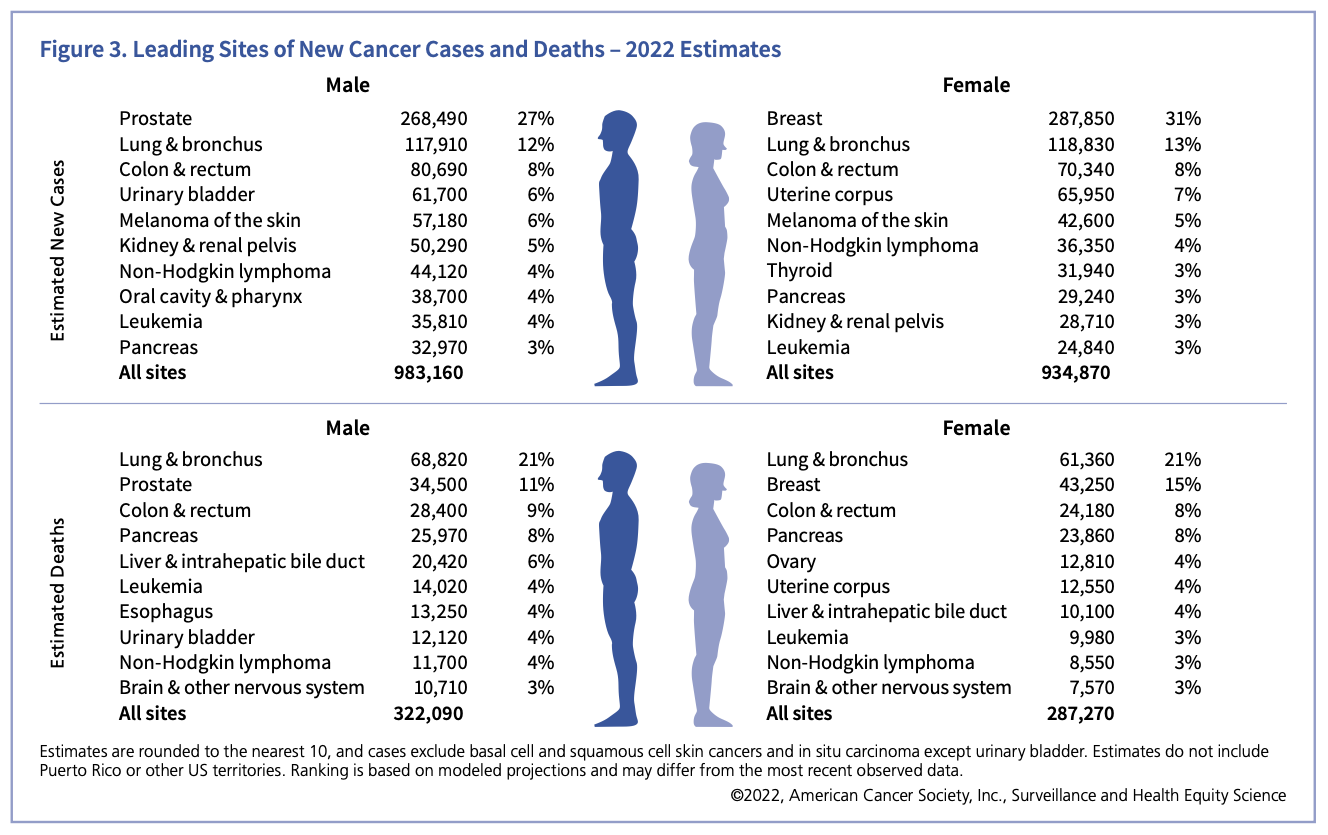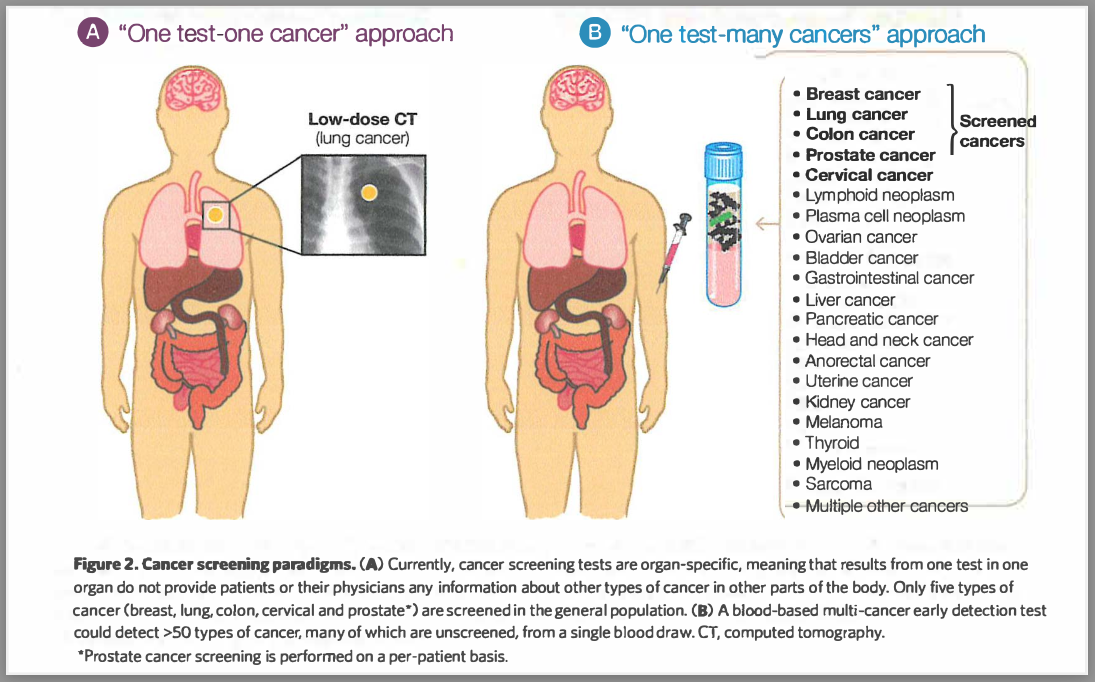In 2023, according to the American Cancer Society[1], more than 1.9 million new cancer cases are expected to be diagnosed in the US, with the most prevalent types being breast, prostate, colon, and lung cancers. This is predicted to result in 609,8200 cancer deaths.
Annual cost related to cancer diagnoses and care in the US is upwards of $200 billion, which is expected to reach $246 billion by 2030.
Risk factors such as alcohol consumption, sleep deprivation, smoking, obesity, and eating highly processed foods has led to a greater number of the new cancer cases in people under age 50. Beyond focusing on prevention, of course, the best way to address this is through better testing and early detection.
I recommend that my patients stay current on the recommended cancer screens such as those for mammogram, Pap, colonoscopy, and prostate.
Epidemiology data suggest that detection of multiple cancer types earlier than stage IV could reduce at least 15% of cancer-related deaths within 5 years.
What is the importance of early cancer detection?
- Finding cancer early is important to improve treatment outcomes and survival.
- Most cancers show no symptoms until later stages when treatment options might be limited.
- Currently, there are 5 recommended cancer screening tests (lung, breast, colon, prostate, and cervical) – although together these account for only 1 in 4 diagnosed cancers in those over age 50.
- 71% of cancer deaths are caused by cancers not commonly screened for today.
- When cancers are diagnosed early, the five-year survival rate is 4 times higher than when diagnosed in later stages.
What is the latest with early cancer detection?
The Galleri® Multi-Cancer Early Detection Test is the most recent next generation screening test approved. The test is supported by the CCGA and Pathfinder trials involving over 20,000 patients. Over 100,000 patients are involved in ongoing Strive and Summit trials
Purpose of the Galleri® Test:
This test is done through a simple blood draw. It looks for a signal shared by more than 50 types of cancer, and if detected, can identify where in the body the signal may be coming from. The test analyzes DNA fragments to detect cancer at a lower threshold of cancer cells and therefore at an earlier stage of cancer, potentially before symptoms emerge.
The test is designed as a one test-many cancers approach versus the one test-one cancer approach as is currently done for cancer screens.
The Galleri® test benefits those adults with an elevated risk for cancer, such as people aged 50 and older. While I would not recommend this for everyone due to cost, it is a reasonable test for those interested in further, more comprehensive screening.
Accuracy of the Test:
The Galleri® test has an 89% accuracy rate in detection across all cancer types, with a 76.3% detection rate in cancers associated with high mortality, such as gastrointestinal (colon-rectal, esophagus, stomach), bladder, head and neck, liver, lung, lymphoma, ovarian, and pancreatic cancers.
The test is 99.5% accurate when no cancer signal is detected, meaning that 99.5% of people who do not have cancer will test negative. Likewise, in only 0.5% of those tested will a cancer signal be detected when no cancer is present (a false-positive test result). This is important in that the low false-positive rate minimizes unnecessary diagnostic procedures.
Limitations of the Test:
- This test does not detect all cancers, and not all cancer can be detected in the blood.
- This test detects cancer signals in the blood but does not diagnose cancer.
- There is no perfect test. The Galleri® test can result in both false negative and false positive results.
- A false positive result will result in unnecessary follow-up tests and imaging studies.
- A test result of “cancer signal not detected” does not rule out cancer entirely.
- A test result of “cancer signal detected” requires further diagnostic evaluation to confirm cancer.
- The is not a stand-alone test so should be used in addition to guideline-recommended cancer screenings such as mammography, colonoscopy, prostate, and cervical screening.
- The cost of the Galleri® test is $900 – at this point, insurance does not cover the cost.
The Future of Early Cancer Detection
Much of the current research in early cancer detection testing is based on identifying metabolites produced by cancer cells. These metabolites can be used as biomarkers or fingerprints of specific cancers.
A Swedish biotechnology company has such a test under development that can detect 14 cancer types in the blood and urine by measuring groups of carbohydrate molecules that are altered by the presence of tumors early in the cancer process. Initial studies show a higher detection rate of Stage I cancers versus other tests.
Other cutting-edge research uses magnetic field and radio waves to analyze level of metabolites released by tumor cells into the blood steam. There are also companies utilizing total body MRI scans to screen for early cancers.
While we continue to learn of advances in early cancer detection, do be sure in the meantime, to schedule your recommended screenings as usual. (Mammogram, Pap, colonoscopy, and prostate screenings).
Sources:
Clarke, Christina. Projected Reductions in Absolute Cancer-Related Deaths form Diagnosing Cancers Before Metastasis, 2006-2015. Cancer Epidemiology, Biomarkers & Prev. 2020:29:895-902
Larkin, James et al. Metabolomic Biomarkers in Blood Samples Identify Cancers in a Mixed Population of Patients with Non Specific Symptoms. Clin Can Res 2022:28(8):1651-1661
Nelson, Roxanne. New Test That Detects 14 Cancers Focuses on Sugars not DNA. Medscape. 2022 Dec 17.
Ofman, J., Hajj, M., Alexander, A. GRAIL and the Quest for Earlier Multi-Cancer Detection.
Siegel, Rebecca et al. Cancer Statistics 2023. CA: A Cancer Journal for Clinicians. 2023:73(1):17-48
Usa, T., Sasamoto, N. Is Early Onset Cancer an Emerging Global Epidemic. Nat Rev Clin Oncol. 2022:19:656-673
[1] Cancer Facts and Figures report, American Cancer Society


